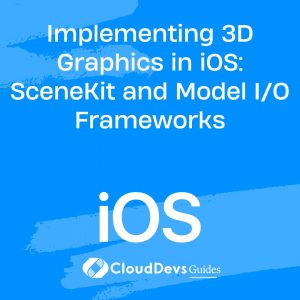Implementing 3D Graphics in iOS: SceneKit and Model I/O Frameworks
In the realm of iOS development, incorporating 3D graphics into your applications can elevate user experience to new heights. Whether you’re creating immersive games, interactive product visualizations, or educational tools, mastering 3D graphics frameworks is crucial. Two powerful tools in the iOS developer’s arsenal are SceneKit and Model I/O frameworks, each offering unique capabilities for rendering and manipulating 3D content.
SceneKit Framework: Bringing Scenes to Life
SceneKit is Apple’s high-level framework for building and rendering 3D scenes in iOS applications. It provides a comprehensive set of tools for creating, animating, and rendering 3D content with ease. Here’s a glimpse into what SceneKit has to offer:
1. Scene Graph Management
SceneKit adopts a scene graph architecture, allowing developers to organize and manage complex 3D scenes efficiently. Nodes represent objects in the scene, such as geometry, lights, cameras, and more, forming a hierarchical structure that simplifies scene composition.
2. Built-in Physics Engine
With SceneKit, implementing realistic physics simulations becomes straightforward. Developers can leverage built-in physics behaviors like gravity, collision detection, and forces to create dynamic interactions within the scene, enhancing realism and interactivity.
3. Materials and Shading
SceneKit supports various material properties and shading models, enabling developers to achieve visually stunning effects. From basic diffuse and specular materials to advanced shaders and textures, SceneKit offers the flexibility to customize the appearance of 3D objects to suit your application’s aesthetic requirements.
4. Animation Framework
Animating objects in SceneKit is intuitive, thanks to its animation framework. Developers can create keyframe animations, skeletal animations, and particle effects to breathe life into their 3D scenes. Coupled with physics simulations, animations in SceneKit can produce captivating and dynamic visual experiences.
5. Integration with ARKit
For developers venturing into augmented reality (AR) app development, SceneKit seamlessly integrates with ARKit, Apple’s AR framework. By combining the power of SceneKit’s 3D rendering capabilities with ARKit’s world-tracking technology, developers can create immersive AR experiences that blend virtual content with the real world.
Model I/O Framework: Simplifying 3D Asset Management
Model I/O framework complements SceneKit by providing efficient tools for importing, exporting, and manipulating 3D assets within iOS applications. Here are some key features of Model I/O framework:
1. Asset Importing
Model I/O simplifies the process of importing 3D models from various file formats, including OBJ, USDZ, and Alembic. By seamlessly loading external assets into your SceneKit scenes, you can leverage a vast library of 3D content available online or create custom assets using external modeling tools.
2. Texture and Material Handling
Model I/O facilitates the creation and management of textures and materials associated with 3D models. Whether it’s applying textures to surfaces, generating UV mappings, or adjusting material properties, Model I/O streamlines the workflow for handling complex material data within your SceneKit scenes.
3. Mesh Processing
The framework offers robust mesh processing capabilities, allowing developers to perform tasks such as mesh optimization, subdivision, and tessellation. By fine-tuning the geometry of 3D models, developers can achieve better performance and visual fidelity in their applications.
Examples of SceneKit and Model I/O in Action
1. Creating a 3D Product Viewer
Imagine developing an e-commerce app that enables users to interact with products in 3D. By integrating SceneKit for rendering and Model I/O for asset management, you can implement a feature-rich product viewer that allows users to rotate, zoom, and inspect items from all angles, enhancing their shopping experience.
2. Building a Game with Dynamic Environments
SceneKit’s physics engine and animation framework make it an ideal choice for game development. By leveraging Model I/O to import 3D assets and SceneKit for scene composition and rendering, you can create immersive gaming experiences with realistic physics interactions, dynamic lighting, and captivating visuals.
3. Developing an Educational App with AR
Combine SceneKit, ARKit, and Model I/O to develop an educational app that brings virtual objects into the real world. Whether it’s exploring the solar system, dissecting virtual organisms, or examining historical artifacts, the integration of these frameworks enables the creation of interactive AR experiences that engage and educate users.
Conclusion
Incorporating 3D graphics into iOS applications opens up a world of possibilities for developers to create compelling, immersive experiences. By mastering SceneKit and Model I/O frameworks, developers can unleash their creativity and build visually stunning applications that captivate and engage users. Whether you’re developing games, educational apps, or interactive product experiences, SceneKit and Model I/O provide the tools and flexibility needed to bring your ideas to life in three dimensions.
External Links for Further Reading:
- Apple Developer Documentation – SceneKit
- Apple Developer Documentation – Model I/O
- Ray Wenderlich – SceneKit Tutorial for Beginners
Unlock the full potential of 3D graphics in your iOS apps with SceneKit and Model I/O today!
Table of Contents









